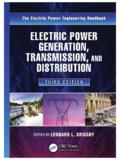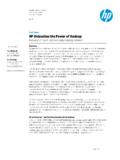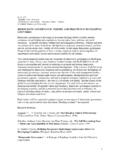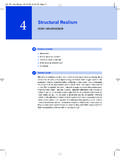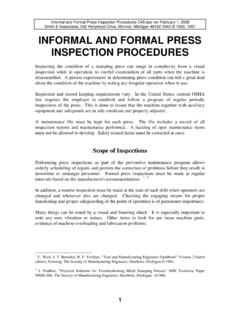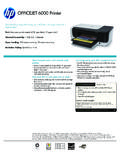Transcription of mechanical power press checklist final - pma.org
1 1 of 8 PMA mechanical power Presses checklist Through its alliance with OSHA, PMA has developed this checklist that either one person at a facility or a full safety committee can use to identify and think about potential safety issues in the plant. For the user s convenience, an action notes section is included at the bottom of the checklist so that any items that may need to be corrected or further explored can be recorded. A reference section is also included at the end of the checklist to offer additional helpful resources related to this topic. mechanical power press Guarding and Construction, General Yes No N/A (b)(1) Are machine components designed and secured to minimize hazards caused by breakage or release of mechanical energy ( broken springs)?
2 (b)(2) Do friction brakes provided for stopping or holding a slide movement require power or force from an external source to cause disengagement? (b)(2) Is brake capacity sufficient to stop the motion of the slide quickly and hold the slide and its attachments at any point in its travel? (b)(3)(i) Do all full-revolution clutch machines incorporate a single-stroke mechanism? (b)(3)(ii) On a full-revolution clutch press , if the single-stroke mechanism is dependent on spring action, are springs the compression type designed to prevent interleaving of the spring coils in the event of breakage?
3 (b)(4)(i) Are foot treadles guarded against unintended operation? (b)(4)(ii) Is there a non-slip pad on all foot pedals? (b)(4)(iii) Are pedal return springs of the compression type and designed to prevent interleaving of the spring coils in the event of breakage? (b)(4)(iv) If pedal counterweights are provided, are the paths of travel for the weights enclosed? (b)(5)(i) Are all hand lever operated presses equipped with a spring latch on the lever to prevent accidental tripping? (b)(5)(ii) If more than one operating station is used on hand-tripped presses, are all operating levers interlocked to prevent press tripping except by the concurrent use of all levers?
4 (b)(6)(i) Are two-hand trip controls protected against unintentional operation? (b)(6)(i) Are two-hand trip controls arranged and constructed so that concurrent operation is needed to trip the press ? 2 of 8 mechanical power press Guarding and Construction, General Yes No N/A (b)(6)(ii) On full-revolution clutch presses, do two-hand trip controls incorporate an anti-repeat feature? (b)(6)(iii) If two-hand trip controls are used on multiple operator presses, do all operators have a separate set of controls? (b)(7)(i) On part-revolution clutch presses, does the clutch release and the brake apply when the external clutch engaging means is removed, deactivated or de-energized?
5 (b)(7)(ii) Is a red-colored STOP control provided with the clutch/brake control? (b)(7)(ii) Does momentary operation of the STOP control immediately deactivate the clutch and apply the brake? (b)(7)(ii) Does the STOP control override all other controls? (b)(7)(iii) With a clutch brake control, is a means of selecting Off, Inch, Single Stroke and Continuous (when the continuous function is furnished) provided to select the type of operation of the press ? (b)(7)(iii) Is the type of press operation (Off, Inch, etc.) capable of supervision by the employer ( by a key switch selector lock)?
6 (b)(7)(iv)(a, and b) Is the Inch operating mode designed to prevent hands in the point of operation by: Requiring the concurrent use of both hands to actuate the clutch? Being a single control protected against accidental actuation and located where the operator cannot reach into the point of operation while operating the control? (b)(7)(v)(a, b, c, and d) Do two-hand controls for single stroke conform to the following requirements: Each hand control is protected from unintended operation and designed to require the concurrent use of both hands to operate the press ? The control system permits an adjustment which will require the concurrent use of both hands during the die closing portion of the stroke?
7 The control system has an anti-repeat feature? The control system is designed to require the release of all operators hand controls before an uninterrupted stroke can be resumed? (b)(7)(vii) Are controls for more than one operating station designed to be activated and deactivated in complete sets of two operators hand controls per operating station and capable of being supervised by the employer? 3 of 8 mechanical power press Guarding and Construction, General Yes No N/A (b)(7)(vii) If all operating controls are bypassed, is the clutch/brake control system designed to prevent actuation of the clutch?
8 (b)(7)(viii) If the clutch/brake control system contains both the single and continuous function, is it designed so that completion of continuous circuits may be supervised by the employer? (b)(7)(viii) Does the initiation of a continuous run require a prior action or decision by the operator, such as the use of a key switch selector lock? (b)(7)(ix) If foot control is provided, is the selection method between hand and foot control separate from the stroking selector and capable of being supervised by the employer? (b)(7)(xi) Is the control of air-clutch machines not running continuous, automatic feeding applications, designed to prevent a significant increase in the normal stopping time if the operating valve mechanism fails?
9 (b)(7)(xi) If such a failure does occur, is further operation of the press inhibited? (b)(7)(xii) Does the clutch/brake control incorporate an automatic means to prevent initiation or continued activation of the single stroke or continuous functions unless the press drive motor is energized in the forward direction? (b)(7)(xiii) Does the clutch/brake control deactivate in the event of failed power or pressure supply for clutch-engaging means? (b)(7)(xiv) Does the clutch/brake control automatically deactivate if the counterbalance(s) air supply fails? (b)(7)(xv) Is the selection of bar operation capable of being supervised by the employer?
10 (b)(7)(xvi) Is a separate push button employed to activate the clutch and capable of activation only if the driver motor is de-energized? (b)(8)(i) Does every power press control system have a main power disconnect switch capable of being locked in the Off position? (b)(8)(ii) Is the motor start button protected against accidental operation? (b)(8)(iii) Do all mechanical power press controls incorporate a type of drive motor starter that will disconnect the drive motor from the power source in the event of control voltage or power source failure? (b)(8)(iv) Are all control circuits and solenoid valve coils powered by not more than a nominal 120-volt supply obtained from a transformer with an isolated secondary?



